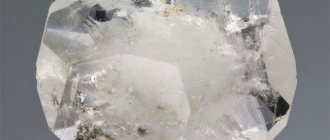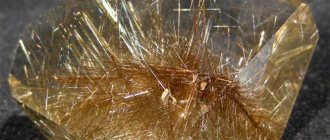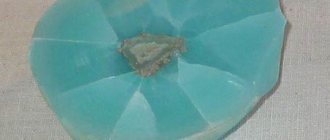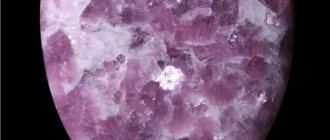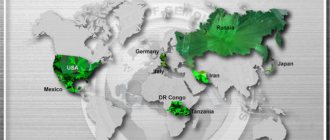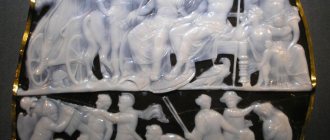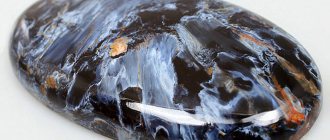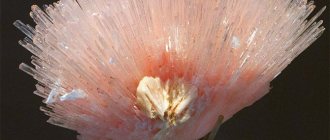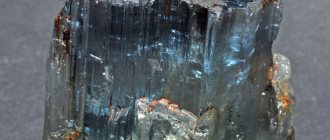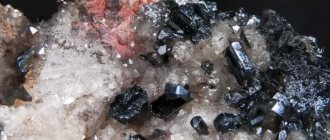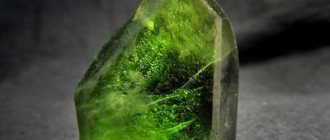- What kind of stone: Ornamental;
- Deposits: Canada, China, Russia, New Zealand;
- Colors: Various shades of green, sometimes colorless to pale bluish;
- Mohs hardness: 5-6;
- Transparency: Translucent;
- Density: 3.1-3.2 g/cm3;
- Formula: Ca2(Mg,Fe)5[Si8O22](OH)2;
- Suitable person according to zodiac sign: Everyone;
- How much does it cost: from 240 rubles.
Actinolite is an unusually beautiful mineral, especially attractive in bright sunlight, thanks to which its surface begins to shimmer with all its facets, casting sparkling rays.
Its best specimens are used in jewelry and stone cutting, and units with a fine-fiber structure are used in the production of tires.
What is this stone?
Actinolite (translated from ancient Greek its name means “radiant stone”) is a rock-forming mineral belonging to the group of amphiboles, which, in turn, are included in the class of silicates.
Its name is due to the presence of a huge number of needle-shaped crystals that form radiant aggregates, giving the stone a delicate silky or bright glassy shine.
The color of actinolite, grey-green-brown, is determined by the high content of silicon and iron.
A typical metasomatic rock formed in contact skarns and metamorphic schists, actinolite occurs as matted fibrous or columnar aggregates.
In places where it occurs, talc, epidote, garnets and various types of quartz are often found.
Chemical composition
The chemical composition of actinolite, taking into account isomorphic substitutions, is expressed by the formula: (Na, K)0-0.5 (Ca2-1.34 Na0-0.66) [(Mg, Mn, Al, Ti)4-2.5(Fe2+, Fe3+ )1-2.5] [(Si8-7.5 Al0-o.5) (O, OH)22] (OH, F, Cl, O)2.
Theoretical compositions:
Ca2Mg4FeSi8O22(OH)2: CaO - 13.29; MgO - 9.11; FeO - 8.51; SiO2 - 56.96; H2O - 2.13.
Ca2Mg2.5 Fe2.5 Si8O22(OH)2: CaO - 12.59; MgO - 11.31; FeO - 20.15; SiO2 - 53.93; H2O - 2.02.
CaO content from 9.3 to 13%; Unlike tremolites, Ca is often replaced by Na and group Y cations, especially in actinolites from glaucophane-containing rocks. Actinolites are known that are transitional to cummingtonites. MgO - usually from 12 to 20%, sometimes reduced to 9.5% (transition to ferroactinolites). Higher contents are possible with significant replacement of Ca by Mg. The total amount of Fe is conditionally limited to the range of 1-2.5 per formula unit, but actinolites with Fe>175 are rare. FeO from 7 to 19%, Fe2O3 in the range of 0-5.5%. MnO from 0.15 to 0.55% (Mn0.02-0.07), rarely less or not detected; An increased MnO content was found in actinolite from the iron ore region of northeastern Labrador and in bissolite from an alpine-type vein at the Puiva deposit in the Urals. Manganese actinolite contains up to 7.4% MnO. Always contains small amounts of alkali metals. The Na2O content usually does not exceed 1%, but with a low calcium content it can reach 5.0%. The K2O content is no more than 0.65%, the highest in actinolites from aureoles of granitoid intrusions, the lowest in actinolites from glaucophane-containing rocks and ferruginous quartzites. The amount of Na + K is from 0.03 to 0.60, sometimes more, their amount in position A of the structure is up to 0.32. Al2O3 - no more than 5%, absent in some actinolites. Cr2O3 is rarely observed, as is P2O5. SiO2 content is in the range of 51-56%. TiO2 up to 0.3-0.8% (up to Ti0.08); F—up to 0.3%, rare; Cl was detected only in actinolites from iron ore deposits.
Varieties
By composition:
Manganese actinolite - manganous actinolite. Discovered in skarns of the Kaso manganese deposit (Japan). Contains up to 7.38% MnO. Its properties are indistinguishable from ordinary actinolite. The most ferruginous manganese actinolite, dark green to gray-green, forms veins up to 5 cm thick, composed of irregular, partly elongated grains, contains inclusions of orthite, and is associated with lemon-yellow garnet. Less ferrous manganese actinolite in the form of colorless crystals was found as a product of hydrothermal alteration of skarn rhodonite; associated with brown garnet and manganphlogopite; some of its secretions are contained in hyalophane crystals.
Actinolite. Fiber aggregate
By the nature of the release:
Actinolite - asbestos - actinolite-asbeste - parallel-fiber actinolite. It differs from tremolite-asbestos in its higher iron content. Synonyms like tremolite-asbestos. Actinolite-asbestos deposits are confined to zones of intense fracturing in altered basic volcanic rocks. Asbestos formation is associated with hydrothermal activity in areas of granite magmatism. Asbestos is contained in veins and veins that are not consistent along the strike, often irregular and with bulges. The length of the zones is up to hundreds of meters. Asbestos is cross- and longitudinally fibrous, the length of the fibers is up to 30 cm. Association with quartz, calcite, albite, epidote, axinite, and sometimes with ore minerals is typical. Small veins are usually monomineral. Examples of deposits: Grushinskoye (Yalta) in Northern Kazakhstan, Kyshgauzskoye in Central Kazakhstan, Gorbunovskoye in the Urals, Khatsavinskoye in the North Caucasus, Chazadyr in Tuva, Esenbulak in Mongolia. Actinolite-asbestos veinlets are also present in the hornfelsed sand-shale oligoclase-chlorite-epidote-actinolite rocks of Ak-Sika, Tuva Aut. region; in apogabbro chlorite-actinolite schists of the Tarcin region (Yugoslavia); in brecciated copper-nickel ore of the Allarechenskoye deposit on the Kola Peninsula. It is used, like tremolite-asbestos, for the manufacture of insulating and acid-resistant materials, but is inferior in quality. As the iron content increases, solubility increases, especially after heating at temperatures above 700°.
Actinolite-byssolite (Saussure, 1796) is a tangled fibrous actinolite. Synonym. Actinolitic zillerite (Fersman, 1913). It differs from tremolite-bissolite in its increased iron content. Formed by hydrothermal alteration of basic rocks, gneisses, and crystalline schists; known in quartz veins; in the voids it envelops crystals of calcite, quartz, magnetite, titanite, albite, pennine, epidote, native silver, prehnite, pyrite, chalcopyrite; fibers are partially included in quartz and calcite crystals. Known in an Alpine-type vein in Puiva in the Subpolar Urals; in voids of desilified pegmatite and in veinlets among amphibolites in association with albite and scapolite in the Emerald Mines in the Urals; with epidote, calcite and grossular in the Kansai skarn lead-zinc deposit, Kuramin Mountains (Uzbekistan); in the voids of the garnet skarn in Mladenov (Bulgaria) it grows on epidote, quartz and calcite with siderite, limonite, desmin, chalcopyrite; in quartz veins cutting gabbroids in the Radautal valley, Harz (Germany); in the alpine veins of the Maderanertal valley (Switzerland); in Allermont (France); in South Oran (Algeria); in Buckingham (Canada).
Jade is a dense cryptocrystalline mass composed of intertwined actinolite needles.
Uralite
History of application
Known to people since ancient times, actinolite was used by magicians, sorcerers and shamans to perform mystical rites and rituals.
Moreover, each nation had its own legends and ideas associated with it:
- The peoples of Africa used the stone in justice as a means to help identify liars. It was given to a person accused of a crime to hold. If the crystal at the same time dimmed or lost its inherent radiance, this was regarded as indisputable evidence of guilt or deception.
- In China, the discovery of actinolite was considered a bad omen. The Chinese were convinced that under no circumstances should they lift the mineral from the ground, much less bring it into their home. It was believed that a crystal that has absorbed the energy of its owner takes on his fate. By taking with him the actinolite lying on the road, a person also risked taking the fate of its former owner.
- Residents of the Urals , in whose territory large deposits of actinolite are concentrated, were confident of the opposite. In their opinion, this radiant mineral is capable of bringing its owner good luck in all matters, wealth and the fulfillment of the most unfulfilled desires.
The first description of actinolite was made in 1794 by Richard Kirwan, an Irish scientist who worked in the fields of meteorology, geology and chemistry. He gave the stone this name.
Meaning
The main use of actinolite is to make statement jewelry of the highest quality:
- Transparent specimens are cut or polished cabochon, and then used as inserts in rings, earrings, rings, necklaces, brooches and pendants.
- Opaque stones are used to make necklaces, bracelets and beads.
Where is it used?
Actinolite has found application in serious industries and the sphere of beauty.
The asbestos variety of stone is used in the production of acid-resistant materials and refractories.
The stone is classified as semi-precious or semi-precious, difficult to process, but looks unique and is affordable. It is taken away by hand-made masters. Transparent crystals are used on earrings, pendants, and rings. The most expensive frame is silver. The rest become beads for necklaces, bracelets, and pendants.
Actinolite cabochon (Ural) 52-56 mm
Collectors strive to obtain pure actinolite (especially “maned” asbestos) and samples intergrown with other minerals.
Physical properties
From the chemical formula of actinolite it follows that the predominant components of its composition are iron and silicon. The color of the crystals depends precisely on their percentage.
In addition to these elements, the mineral contains all sorts of impurities, which are compounds of magnesium, titanium, potassium, aluminum and manganese, giving the crystals additional shades.
Actinolite, which has crystals of an elongated (columnar or needle-shaped) shape, has:
- Hardness equal to 5-6 points on the Mohs scale.
- Monoclinic system.
- Perfect cleavage. Angles between cleavage planes of 56 and 127 degrees give the crystals a hexagonal or diamond-shaped cross-section.
- Splintered or stepped fracture.
- Density equal to 3.1-3.2 g/cm3.
- Strong glass luster. Asbestos has a silky sheen. Some samples have a “cat’s eye” effect due to the shine of the finest thread-like fibers.
- Varying degrees of transparency: crystals can be completely transparent or translucent.
- The greenish-white color of the line left on the surface of a rough porcelain sponge cake.
- High fragility.
- Resistant to acids (except for hydrochloric acid, which can partially dissolve crystals).
- The ability to sharply increase electrical conductivity during oxidation and dehydration. After dehydration is completed, the electrical conductivity decreases to its original value.
- Restrained color scheme. Crystals can be dark green, grey, brown, grayish or bluish green. There are also almost colorless specimens.
Physico-chemical properties of stone
| Property | Description |
| Formula | Ca2(Mg,Fe)5[Si8O22](OH)2 |
| Hardness | 5 — 6 |
| Density | 2.9 - 3.3 g/cm³ |
| Refractive indices | nα = 1.613 - 1.646 nβ = 1.624 - 1.656 nγ = 1.636 - 1.666 |
| Fragility | fragile |
| singonia | Monoclinic |
| Kink | Stepped, splintered |
| Cleavage | Perfect |
| Shine | Glass or silky |
| Transparency | Transparent or opaque |
| Color | Grayish green to dark green, brown, gray |
Place of Birth
Actinolite is not a rare mineral. Its rich deposits are scattered all over the world.
The most significant deposits are located in the following areas:
- Canada.
- China.
- Russian Federation (the Middle and Southern Urals, Primorsky Krai, Transbaikalia and Karelia are rich in actinolite).
- New Zealand.
Transparent crystals of the highest jewelry quality are mined in Northern India and Tanzania.
Italy is famous for its crystals, colored in beautiful gray-blue tones.
The extraction of actinolite, which occurs in the thickness of other rocks, is carried out in the following areas:
- USA (in Wyoming, Virginia, California, Alaska);
- Austria;
- Slovakia;
- Canada (in British Columbia);
- Switzerland;
- Brazil (in the state of Minas Gerais);
- Afghanistan;
- Madagascar.
Ukraine (the territory of the Rostov region and the Northern Azov region) is a supplier of crystals of jewelry and ornamental quality.
Varieties, colors
The main place in the color palette of actinolite belongs to the green color and its various shades. Due to the presence of impurities in the chemical composition of the mineral, it also contains brown, gray and bluish tones.
After a series of fundamental studies of actinolite at the end of the 18th century, scientists proposed a classification that made it possible to systematize its varieties according to color and structural features.
According to this classification, actinolite has the following varieties:
Nephritis
A gem-quality mineral with a viscous structure and, thanks to the admixtures of manganese and chromium, an incredible number of colors and shades: from white and pale light green to dark green and even black.
The following shades are most typical for the color palette of jade: emerald, light green, grass and swamp green. The rarest and therefore most valuable are crystals colored in different shades of red or blue.
Known to mankind for thousands of years, jade is an ornamental stone, especially revered in the countries of Southeast Asia and, above all, in China.
According to the beliefs of ancient people, the energy of white jade can protect a person from the influence of dark forces, maintain peace and mutual understanding in the family, and also increase life expectancy.
Only members of the imperial family and high-ranking nobles were allowed to have jewelry and products made from jade, which was considered the imperial stone.
Nowadays, tabletops, combs, vases, bowls and boxes are made from it, used as jewelry inserts in rings, brooches and earrings, and necklaces and bracelets are made.
Chinese stone carvers make expressive figurines of birds and animals, ritual accessories for magical rituals, and objects for lithotherapy sessions from jade. Large jade deposits are located in China, the USA, Poland, Italy, Canada, Germany and Kyrgyzstan.
Bissolit
A rare variety of actinolite with a fine-fiber structure. It occurs in nature in the form of light hair-like and cotton wool-like aggregates, as well as fibers collected in bundles. Individual fibers consist of fine-needle crystals, the thickness of which is equal to thousandths of a millimeter in diameter.
The mineral owes its name (it comes from the ancient Greek words “byssos” - flax and “litos” - stone) to its visual resemblance to combed flax fibers. Byssolite fibers are coarser than those of asbestos and have the same thickness along their entire length.
Being straight, they do not intertwine anywhere, are characterized by increased fragility (when bent, bissolite breaks easily) and insignificant flexibility. Unable to split, when abraded they form sharp fragments.
The color of bissolite ranges from white and soft gray to grassy green. Some collectible specimens resemble tufts of bright green young grass.
Characteristic of alpine-type veins, byssolite is found in some parts of Western Europe, located in Romania, Scotland, Hungary, Austria, Sweden, Germany, France, and Switzerland. In Russia, byssolite was found on the Kola Peninsula and the North Caucasus.
Tremolite
The stone received its name in honor of the Tremol Valley, located in Switzerland, where it was first found - a light variety of the mineral containing no more than 3% iron.
Its elongated or needle-shaped crystals, depending on the presence of additional impurities, can be colorless, white, pearl-gray, yellowish, cream or light green.
Smaragdite
Named by analogy with the ancient Russian name for emerald - smaragd - an expensive and rare gem of a bright green color, visually reminiscent of an emerald and often having a “cat’s eye” effect.
Large deposits of smaragdite are concentrated in the Swiss Alps, Austria and Germany.
Amyant
Translated from ancient Greek - “pure, unsullied” - a type of actinolite, which is painted in pure purple tones and has no dark spots. Mineralogists call it actinolite or amphibole asbestos.
Under mechanical influence, amianth easily splits into the finest fibers, characterized by high strength and elasticity.
Fire resistance and immunity to acids makes amphibole asbestos a valuable raw material used in the production of asbestos-cement pipes (they are indispensable in electrical engineering and construction). As well as asbestos fabric used for sewing heat-insulating clothing and thermal insulation of heating devices and stoves.
Dry asbestos is used for lining gas turbines and steam boilers. Thermal insulation of pipelines and heating devices is also carried out using asbestos thick cardboards, plaits and fabrics.
Types of actinolite
The following subspecies of actinolite are distinguished according to their color:
- Jade - in addition to iron, contains chromium and manganese, due to which it is characterized by the widest palette of colors: from almost white through yellowish-green, grass, emerald, swamp green to black. Blue and red varieties are rare and most valuable.
- Bissolite is a fine-fiber mineral of greenish or green-gray color, deposits of which are located in the Alps. It got its name because of its external resemblance to flax fibers.
- Smaragdite is a rare bright specimen, the rich color of young grasses.
- Amianth is an actinolite of violet tones without dark spots.
Magic properties
The magical properties of actinolite, symbolizing courage, decency, loyalty and wisdom, are unusually strong.
Thanks to them, the stone is able to:
- Easily identify evil and deceitful people. In their presence, he loses his bright shine.
- To help people (businessmen, scientists, lawyers, managers) whose profession involves the need to negotiate and make responsible decisions every day.
- Bring its owner extraordinary luck and success in any field of activity, thanks to which he will be able to quickly advance up the career ladder.
- Help your owner put things in order, set life priorities correctly and learn to find the only right solutions in difficult situations.
- Facilitate the conclusion of profitable contracts, thereby contributing to the achievement of financial stability and independence.
How to care
Actinolite is fragile, medium hard, and afraid of water. Even samples need to be taken care of, taking into account these properties of actinolite:
- Select a separate spacious box for storing jewelry. For samples - a box of suitable dimensions.
- Protect from falls, impacts, compression.
- Remove dust with a dry soft cloth.
The asbestos variety of the mineral requires special treatment. In a humid environment, when interacting with water, actinolite crystals stick together. It is not advisable to even touch fibrous samples: they may crumble.
The mineral is indifferent to heat and most acids.
Medicinal properties
Lithotherapists claim that actinolite can be used for:
- Treatment of skin diseases. You can get rid of eczema, ringworm or skin fungus faster with the help of paired bracelets worn on both hands. A ring worn on your right hand will solve the problem of flaky skin. A pendant or earrings with an actinolite insert will help improve the condition of your hair and say goodbye to dandruff. The jewelry used should be set in silver, which can enhance the healing properties of the stone.
- Improving the functioning of the cardiovascular system.
- Restoring potency.
- Strengthening blood vessels.
- Treatment of diseases of the intestines , digestive and respiratory systems.
- Improving the condition of bones and joints.
- Eliminate mild mental disorders and restore peace of mind.
- Removing the patient from an apathetic state during prolonged depression.
Who is suitable according to their zodiac sign?
Actinolite, which has good compatibility with all signs of the Zodiac, is most suitable for people born under the constellations Aquarius and Sagittarius .
In order for a stone worn as a talisman to bring good luck, the future owner must buy it himself, and then take care of it and not transfer it into the wrong hands.
Otherwise, a stone that comes into close contact with its owner may take away with it the positive energy given to it, thereby provoking serious problems with health and material well-being.
Talismans and amulets
Actinolite, used as a talisman, amulet or amulet, is capable of:
- change the life of its owner for the better;
- help a person understand not only himself, but also the feelings of loved ones;
- teach students to concentrate attention when performing responsible work.
In order for the stone to fully reveal its magical properties, it is recommended to wear it so that it has close contact with the skin. This condition is best handled by a bracelet, pendant, ring, pendant or beads. A gold frame will greatly enhance the magical power of the stone.
A talisman with actinolite will benefit only smart, honest, brave, loyal and decent people who are able to share their positive energy with others.
Mineral Change
During progressive metamorphism it is replaced by hornblende. In rocks of the glaucophane metamorphic facies and in ferruginous quartzites, actinolite was replaced by alkaline amphiboles, phlogopite or cummingtonite. Actinolite was replaced by epidote, zoisite, or an aggregate of zoisite and quartz; the (010) plane of actinolite is parallel to the (100) zoisite. Some actinolites are chloritized. The change in actinolite under hydrothermal conditions (T = 150–500°, P = 1–8 kbar) was studied experimentally.
Other uses of stone
- Actinolite intergrowths and unusually shaped crystals are collectible objects.
- Tangled fibrous varieties of actinolite (primarily jade), which have high viscosity and are easy to polish, are used as an ornamental stone. It is used in the manufacture of small plastic items: expressive figurines, figurines and spectacular souvenir balls.
- Actinolite produces magnificent beads and faceted beads, which are used for embroidering paintings and icons.
- Fine-fiber actinolites, endowed with good elasticity, are used as a filler in the production of rubber for car tires.
Crystallographic characteristics
Syngony. Monoclinic.
Crystal structure
Isostructural with tremolite; Mg in octahedral positions is partially replaced by Fe2+. Typically, the M(2) positions are depleted in Fe2+ compared to M(1) and M(3). The distribution of iron between the M(1) and M(3) positions may be different.
Actinolite crystals with talc. North Caucasus
Form of actinolite in nature
The crystals are needle-shaped, prismatic.
Twins at (100) are simple and polysynthetic. There are indications of twinning along (010) and (101).
Aggregates . Granular masses, porphyroblasts, columnar and radiant aggregates, parallel fibrous (asbestos) and tangled fibrous (bissolite) deposits.
Price
Approximate cost of natural actinolites:
- Cost of tumbling (hairy, Brazil) size 5-15 mm: 50 g - 240 rubles; 100 g – 380 rub.; 1 kg – 2400 rub.
- Natural actinolite (collector's item, Southern Urals), 60x25x18 mm – 460 rub.
- Cabochon made of actinolite on a glass substrate (Yamalo-Nenets district), 63x38x5 mm – 400 rub.
- Oval cabochon without backing, intended for braiding with leather or beads (Southern Urals), 56x37x7 mm – 390 rub.
- Silver ring with inserts of actinolite, apatite, quartz and muscovite – RUB 9,000.
- Nickel silver ring with actinolite and quartz inserts – RUB 2,150. Actinolite, mined in the Middle Urals (Nizhny Tagil), has a “cat’s eye” effect.
- Bracelet made of natural Ural actinolite made of beads (9 mm in diameter) assembled on an elastic thread - 1200 rubles.
- A string of beads weighing 64 g and 40 cm long, consisting of 21 rhombic-shaped beads (16x16 mm, hole diameter 1.2 mm) – 380 rubles.
Crystal optical properties in thin preparations (sections)
In thin sections in transmitted light it is weakly colored, pleochroism according to Ng is light green, grayish-green, rarely dark green, according to Nm it is pale green or yellowish-green, according to Np it is colorless or yellowish, sometimes pinkish. Brown tones of pleochroism are not typical. Sometimes there is uneven coloring of individuals. Biaxial (—), very rarely (+). The plane of the optical axes (010). In some actinolite asbestos, due to the deformation of the fibers, the extinction is direct. Elongation (+) ng = 1.640 - 1.665, nm = 1.625 - 1.650, np = 1.615 - 1.643, ng - np = 0.017 - 0.028. 2V = 70 - 84°, up to 87 and 90°18′ with low Ca content. 2V = 40 - 50° was noted for asbestos varieties. Sometimes weak dispersion r < v. Twinning. according to (100) simple and polysynthetic, twins according to (010) are indicated. Sometimes, under a microscope, lamellar cummingtonite inclusions oriented along (100) and (101) are detected; they partially experienced collective recrystallization. In actinolite from the Ruby Mountains (USA), the thickness of lamellar cummingtonite inclusions is up to 50 µm; their number is 45% by volume. When actinolite is incompletely replaced by common hornblende, intergrowths with a common axis b are formed; the boundaries between individuals are uneven but clear. The manganese actinolite contained orthite inclusions surrounded by pleochroic courtyards.
Care and storage
Caring for actinolite consists of regularly cleaning the stone from dust and dirt under cool running water using a soft brush.
The storage of this fragile mineral (especially its transparent samples), which is afraid of strong impacts, compression and intense exposure to bright sunlight, deserves special mention.
Jewelry with actinolite should be stored in individual bags made of soft fabric (for example, velvet or flannel), designed to protect the stone from contact with other jewelry.
It is best to keep these bags in a tightly closed box that does not let in sunlight.
Origin and location
Metamorphic - in skarns (in contacts with limestones), found in crystalline schists (talc, chlorite). Sometimes it is the main rock-forming mineral (actinolite shales).
Actinolite is a rock-forming mineral of metamorphosed mafic rocks of the greenschist facies, found in hydrothermally altered igneous and metamorphic rocks, sometimes associated with the processes of formation of magnetite or copper-nickel ores.
During the metamorphism of basic volcanic-sedimentary and subvolcanic rocks, actinolite is formed in association with albite, epidote and chlorite, mainly along dark-colored minerals, but also replaces plagioclase. At the initial stages of metamorphism of volcanic-sedimentary rocks, detrital grains of hornblende are overgrown with actinolite, and fine-needle actinolite is released in the cement. In volcanogenic rocks, actinolite replaces phenocrysts of dark-colored minerals. During regressive metamorphism and in the process of metasomatism, actinolite is formed from dark-colored minerals of igneous and metamorphic rocks of basic, less often intermediate composition; in tectonically weakened areas it is deposited to form veins and nest-like accumulations, for example, in the Urals, on the Kola Peninsula, in Central Japan. Actinolite-asbestos veins are also found in fracture zones in the main rocks. During intense metamorphism, actinolite and albite-epidote-actinolite schists with chlorite, calcite, and sometimes muscovite are formed. However, actinolite hornblende is more common in shales than actinolite. In greenschist strata, the albite-epidote-actinolite association is characteristic of zonal complexes and halos of granitoid intrusions. When moving to higher temperature associations of the amphibolite facies, zoned amphibole crystals appear with a core of relict actinolite and a shell of more intensely colored (often blue-green) hornblende. Zonal metamorphic complexes with actinolite as a rock-forming mineral are known in New Zealand, Scotland, and the Abukuma Plateau in Japan. In the Southern Urals, albite-epidote-actinolite rocks form a narrow cutting zone along the main volcanic rocks, pyroclasts and terrigenous-sedimentary rocks. The transition zone to unaltered rocks has a quartz-chlorite composition. The intensity of metamorphism and the amount of actinolite increase in dislocation zones, where a gradual transition to metasomatic rocks with pyrite mineralization is observed. Acicular and asbestos-like actinolite is found in pyrite deposits. Actinolite is found in halos of granitoid intrusions in California, the USA, South America, Tuva and other areas. In some places, the mineral is found in zones of contact between granitoids and volcanic-sedimentary or metamorphic rocks, for example, in the river basin. Tutkhun in Azerbaijan it is part of various hornfels of volcanic-sedimentary rocks; in the area of the Emerald Mines in the Urals, it forms dense clusters and lens-shaped bodies up to 2.5 m long in the phlogopite zone of desilified pegmatites, composes reaction zones at the contact of diorite with serpentinites; in the area of the Złoty Stock gold deposit in Lower Silesia (Poland), it is developed in amphibolites near the contact with granitoids. In an unusual paragenesis with biotite, K-feldspar, plagioclase and quartz, actinolite is found in the Durbachites of the Central Bohemian Massif, where it contains pyroxene relics and was probably formed during metamorphism.
Actinolite. Solid fine-grained masses
In magnetite deposits associated with iron ore skarns and metasomatites , actinolite is a widespread mineral formed during various stages of formation of these deposits. Actinolite, associated with albitization of host intrusive, carbonate and other rocks, is associated with albite, epidote, magnetite, titanite, and apatite. It often replaces skarn minerals, while pyroxene-magnetite deposits are transformed into actinolite-magnetite deposits, while at the same time it is deposited in fracture zones with magnetite, quartz and carbonates. Actinolite from the later stages of mineral formation is associated with chalcopyrite, pyrrhotite, pyrite, and sphalerite. The iron content of actinolite is determined by the composition of the rocks it replaces and varies widely (low-iron actinolite in barren metasomatites and ferroactinolite in ore deposits). Examples of skarn-metasomatic iron ore deposits with widespread actinolitization are: Benkalinskoye, Shagyrkulskoye and Sorskoye in Southern Turgai, Lavrenovskoye in Kuznetsk Ala-Tau, Anzasskoye in Khakassia, Beloretskoye in Gorny Altai, the Irbinsky ore field and Odinochnoye deposits in the Eastern Sayan; deposits of the Norberg region in Sweden. Actinolite is also known in ores and associated metasomatites of copper-nickel deposits; associated with biotite and ore minerals, in brecciated areas it composes asbestos veins or forms needle-shaped crystals deformed to helical shape. Examples: Allarechenskoye, Vostok and Pechenga deposits on the Kola Peninsula, nickel-bearing rocks of the Burma massif in the Far East. In Alpine-type veins, actinolite is released in the form of crystals and felt-like aggregates.
Actinolite is one of the common minerals in glaucophane-bearing regionally metamorphosed rocks. Associated with glaucophane, crossite, epidote, chlorite, sericite, albite, garnet, quartz, stilpnomelane, pumpellyite, lawsonite, titanite, rutile, leucoxene, hematite, magnetite. Often actinolite and glaucophane form different sections and zones of the same crystal, the boundaries between them are uneven but clear; in zoned crystals, actinolite usually composes the core, and glaucophane the outer zone, but reverse relationships are also possible; less often, both minerals form different grains. According to Klein, at low temperatures there is a miscibility gap in the actinolite-glaucophane series; at higher temperatures, a continuous transition from actinolite to glaucophane and crossite is possible. According to Brown, the association of actinolite with glaucophane is always disequilibrium and occurs in conditions bordering the glaucophane and greenschist facies; the overgrowth of one amphibole by another and partial replacement are caused by fluctuations in P-T conditions during the process of metamorphism. The Na content in the M(4) position of actinolite, which is in association with albite, chlorite and iron oxides, increases with increasing pressure; at certain temperatures it can be used for geobarometry. Actinolite in glaucophane and greenschists is known in the state. California and in Washington (USA), in Japan, in France, in Venezuela, on the island of Tasmania, in New Zealand. In some ferruginous quartzites, actinolite is one of the most abundant silicates; associated with quartz, magnetite, hematite, chlorite, carbonates (calcite, dolomite or ankerite), cummingtonite, grunerite, sometimes with later alkaline amphiboles. Paragenesis varies somewhat depending on the composition of the original rocks and the degree of their metamorphism, for example, in hematite-magnetite quartzites KMA actinolite occurs with ankerite and dolomite, in magnetite quartzites it is more ferruginous and forms close intergrowths with calcite and magnetite; In some places the mineral is confined to calcareous layers. It is noted in ferruginous quartzites of the Kursk magnetic anomaly, Krivoy Rog basin, Olenegorsk and other deposits of the Kola Peninsula, in Canada in the province. Quebec and in the Itchen Lake region.
How to distinguish from a fake?
To ensure the naturalness of the mineral, it is recommended:
- Hold the stone over the candle flame. The fake stone will immediately melt, while the natural gem will remain unchanged.
- Place the mineral in a container with acid. The structure and color of natural stone will not change.
Interesting Facts
- Actinolite is endowed with the ability to enhance the positive qualities of its owner and attract good luck to him. With its help, you can accurately determine your life purpose. However, in order for a stone to fully reveal its magical properties, it must have only one owner. The energy of the mineral and its owner are intertwined so closely that the loss of the stone can lead to the loss of both acquired wealth and health. That is why it is recommended to protect the mineral like the apple of your eye.
- Actinolite, associated with its owner forever and containing his destiny, is strictly prohibited from being re-gifted or given to anyone for temporary use or storage.
- Also, you should not pick up and leave a stone lying on the road, since along with it the misfortunes of the previous owner may pass to the new owner.

